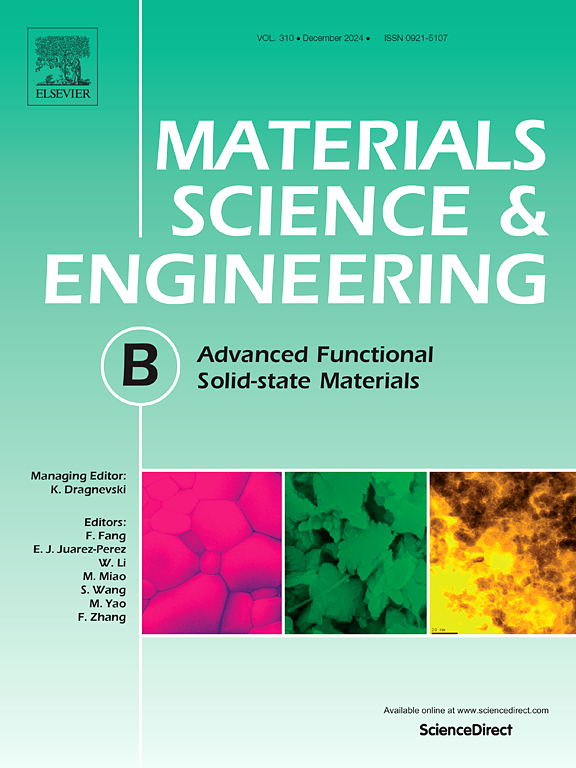Highly stable and efficient catalyst fabricated with in situ exsolved Co-Fe bimetallic nanoparticles anchored on (Ba0.9K0.1)0.9Co0.5Fe0.4Nb0.1O3-δ for CO2 electrolysis
IF 4.6
3区 材料科学
Q2 MATERIALS SCIENCE, MULTIDISCIPLINARY
引用次数: 0
Abstract
Solid oxide electrolysis cells (SOECs), featuring high current density and Faradaic efficiency, have been extensively recognized for CO2 electrolysis abilities. However, it is a challenge to find high performance electrode materials with excellent catalytic activity and preferable stability. Herin, hetero-structured perovskite with exsolved Co-Fe nanoparticles is developed via in-situ reduction of the (Ba0.9K0.1)0.9Co0.5Fe0.4Nb0.1O3-δ ((BK)0.9CFNb). The corresponding SOEC R-(BK)0.9CFNb/LSGM/LSCF achieves excellent electrochemical performance with a current density of 0.813 A cm−2 at 1.5 V and 800 °C, which is 30 % higher than the counterpart with untreated (BK)0.9CFNb cathode. Its high catalytic activity is attributed to electron feeding effect of in situ exsolved Co-Fe nanoparticles and enhanced CO2 adsorption with high concentration of oxygen vacancies in perovskite substrate surface. Moreover, the R-(BK)0.9CFNb-cell shows much better stability than parent (BK)0.9CFNb-cell, which is ascribed to the structural anchoring of the alloy nanoparticles. This study provide an attractive strategy for the future development of SOECs.
用原位溶出的Co-Fe双金属纳米颗粒锚定在(Ba0.9K0.1)0.9Co0.5Fe0.4Nb0.1O3-δ上制备了稳定高效的CO2电解催化剂
固体氧化物电解电池(SOECs)具有高电流密度和法拉第效率的特点,在二氧化碳电解方面得到了广泛的认可。然而,寻找具有优异催化活性和良好稳定性的高性能电极材料是一个挑战。通过原位还原(Ba0.9K0.1)0.9Co0.5Fe0.4Nb0.1O3-δ ((BK)0.9CFNb),制备出了具有外溶Co-Fe纳米颗粒的异质结构钙钛矿。相应的SOEC R-(BK)0.9CFNb/LSGM/LSCF在1.5 V和800℃条件下,电流密度为0.813 a cm−2,比未处理的(BK)0.9CFNb阴极高30%,具有优异的电化学性能。其高催化活性归因于原位外溶的Co-Fe纳米颗粒的电子馈送效应和钙钛矿衬底表面高浓度氧空位增强的CO2吸附。此外,R-(BK)0.9 cfnb电池的稳定性明显优于母体(BK)0.9 cfnb电池,这主要归因于合金纳米颗粒的结构锚定作用。本研究为国有企业的未来发展提供了一个有吸引力的策略。
本文章由计算机程序翻译,如有差异,请以英文原文为准。
求助全文
约1分钟内获得全文
求助全文
来源期刊

Materials Science and Engineering: B
工程技术-材料科学:综合
CiteScore
5.60
自引率
2.80%
发文量
481
审稿时长
3.5 months
期刊介绍:
The journal provides an international medium for the publication of theoretical and experimental studies and reviews related to the electronic, electrochemical, ionic, magnetic, optical, and biosensing properties of solid state materials in bulk, thin film and particulate forms. Papers dealing with synthesis, processing, characterization, structure, physical properties and computational aspects of nano-crystalline, crystalline, amorphous and glassy forms of ceramics, semiconductors, layered insertion compounds, low-dimensional compounds and systems, fast-ion conductors, polymers and dielectrics are viewed as suitable for publication. Articles focused on nano-structured aspects of these advanced solid-state materials will also be considered suitable.
 求助内容:
求助内容: 应助结果提醒方式:
应助结果提醒方式:


